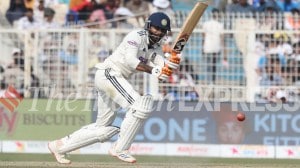‘From simple to complex, we treat all patients, even when beds are full’
In the pipeline is a rate contract system for the ATC for implants, plates, and other medical devices to ease the situation for patients, says Kumar
 Dr Vishal Kumar, Additional Professor of Orthopaedics, who has taken over as the Nodal Officer, Advanced Trauma Centre, PGI. (Express Photo)
Dr Vishal Kumar, Additional Professor of Orthopaedics, who has taken over as the Nodal Officer, Advanced Trauma Centre, PGI. (Express Photo)Dr Vishal Kumar, Additional Professor of Orthopaedics, who has taken over as the Nodal Officer, Advanced Trauma Centre, PGI, tells Parul the roadmap and plans for the centre which, he says, is the best in the country.
The Advanced Trauma Centre of PGI has a large influx of patients, with a shortage of beds and space always a challenge. What are the ways to streamline the ATC for patients?
The bed occupancy in the ATC is 300%. We have 100 beds and about 300 patients at any given time, with patients also on trolleys. In the given situation, I can say without a doubt that the ATC is the best in the country, and we have proved it time and again.
At any given time, there are more than 100 patients of orthopaedics here, and I agree that there is discomfort, but patients have trust in the level of care and belief in the treatment here. Many patients can afford to go to private hospitals, but they trust only PGI for its expertise and transparency. We don’t refer any patients who come to us, even if a case is simple and can be handled by another hospital, and even when the beds are full.
We have a very efficient triage system here, where patients are treated as per their needs by experts from all specialties, 24/7, despite the challenges we face. Simple to complex, we don’t refer or send anyone away from PGI, and the survival rate is very high. Yes, there is a lot of finger-pointing, and we know there is always a scope for improvement and progress, and that’s what my effort and plan is as the new Nodal Officer of ATC. I am thankful to our director, who has entrusted me this responsibility.
What are the changes that you have are seeking to implement for a more effective ATC at the institute?
Patients always feel a lack of communication with doctors, and to address this, we have made a counselling room just outside the OTs at the ATC, where the treating doctors can address the concerns, queries of patients and attendants regarding their disease, injury, treatment, and future course of action.
For many, this will be a comfort zone, and a trust and confidence-building exercise with doctors. We also have a spacious plaster room and dressing room now for patients to ease their burden.
We have also planned an emergency kit system for the optimum use of resources. Patients are classified according to the seriousness of injuries and diseases into green, yellow, and red. We are planning to develop kits according to this need, with all medicines, equipment, dressings, etc. needed for patients put on trolleys, like a green kit or a red kit, so that nurses and residents’ doctors do not need to scramble for basic things needed for treatment. This will save time and will also help in streamlining lifesaving resources.
Patients in the ATC and Emergency also find it tough to get the medical equipment needed for immediate treatment, as there is a discrepancy in price and quality at various chemists and medical stores, and many feel lost. Is there any plan to address this pressing issue?
In the pipeline is a rate contract system for the ATC for implants, plates, and other medical devices to ease the situation for patients.
Minimum standards will be laid down as per the bureau of Indian Standards, and all vendors will have to give a certificate of the standards, quote and agree to the minimum lowest price, and all rates will be displayed, that patients and surgeons can choose, and this will ensure that all get the same quality. We hope to create a space in the ATC for this, and it will be an example for the nation.
Does the ATC treat patients from across the region?
We have a high number of cases of accidents from Punjab, Haryana, Himachal Pradesh, Jammu and Kashmir, adjoining Uttarakhand and Uttar Pradesh as treatment is easily available, affordable and multi-faceted here and there is word-of-mouth trust among people in the institute. The maximum number of patients are Ayushman card users and we take pride in serving our patients in coherence with the vision of our government. PGI stands committed in delivering world-class treatment to the last man in the queue. As the number of patients is increasing, the discomfort is high, but we deliver. As a doctor, I can’t refuse anyone, no matter how big we are as a tertiary care referral hospital. We are fully equipped, with 24×7 CT scan and no waiting for an MRI in the ATC. We have five OTs in ATC, and OT 6 operates from 8 am to 5 pm. Purchase of further equipment, monitors, ventilators etc. to strengthen an already robust system is in place.
What about new recruitments to address staff shortage?
Recruitments are ongoing, and apart from a proposal of more than 300 nursing staff, there has been a faculty recruitment of more than 100 for the institute. More faculty will be recruited for the ATC, and we also have a system of relievers for the hospital and sanitary attendants.
Tell us about your journey in the field.
I come from a village in Bihar, and did my MBBS from Kolkata Medical College. My MS is from PGI, an institute that encourages young professionals and gives them great responsibility and an opportunity to serve people, do research, and grow as a human being and a specialist. My wife is a gynaecologist at Dr B R Ambedkar Institute of Medical Sciences, Mohali. I took over as Nodal Officer of the ATC a few months back.
I see it as an opportunity to prove myself and deliver the goods.







